28 April, 2017

Join us for a free performance of migration themed music by Street Orchestra London this Sunday at 2:30pm with 100 Images of Migration as the gallery backdrop.
We are welcoming this renowned pop-up orchestra on their second tour. They will also be performing at the Barbican on Sunday.
The set includes music you’ll know and new commissions. It will last approximately 45 minutes.
Where: Migration Museum at The Workshop. Map here.
When: Sunday April 30 at 2:30pm
We look forward to seeing you then.
8 April, 2015
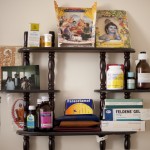
Guest blog by Yasmin Gunaratnam, Goldsmiths College
‘…this is your first home, you were born here. That’s a powerful thing,
don’t ever forget it. But it may not be your last, you understand. And
that’s all right too. It will be beautiful in England even though the
difference will surprise you. You’ll just have to search for it.” (p.82-3).
These are the consoling words of grandfather, Bee Fonseka, to his beloved Alice, in Roma Tearne’s richly textured novel Brixton Beach. With her Sinhalese mother, the nine-year-old Alice is leaving Sri Lanka to join her Tamil father in 1960s London. They are migrating at a time when the island is imploding under the strain of yet another cycle of inter-communal violence.
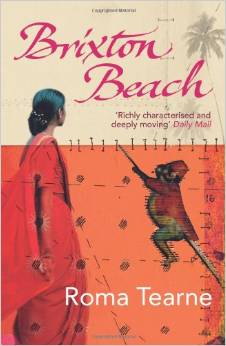
At times, the discordant plotlines faced by the characters in Brixton Beach have come uncomfortably close to my own migration story and its entanglements with a mixed heritage household. Despite moving to London when I was five, Sri Lanka remains an existential touchstone, a place etched deep into my being. So many small and random memories – warm rain, my grandmother’s house full of aunties, uncles and cousins, standing on a broom as my uncle polished red cement floors – have never left me and continue to surface. My ever-changing relationship to the island, from the wrench of being uprooted to the search for Bee Fonseka’s ‘different’ beauty in England, changed once again when my parents died in 1992.
As I took part in death rituals I knew little about, listened to relatives and friends reminiscing and pored over family photos, my personal grief snagged on other losses. I began to search for contemporary writing and research on migration, death and bereavement – surely there must be others who have gone through this? I found very little and this absence bothered me. In 1995, I started a doctoral research in a London hospice, followed by a series of projects on migrants, illness, ageing and death.
The research, which included oral history interviews, coincided with a broader historical shift – the ageing and dying of Britain’s cohort of post-war migrants. My book ‘Death and the Migrant’ documents this social transition and also records the narratives of those providing end of life care in hospices and in the community. Many who provide the care are migrants themselves. My more recent British Academy funded project ‘Case Stories’ has built on this work to create a digital archive of stories, images, poems and art on ‘social pain’ at the end of life; the pain of social exclusion and injury.
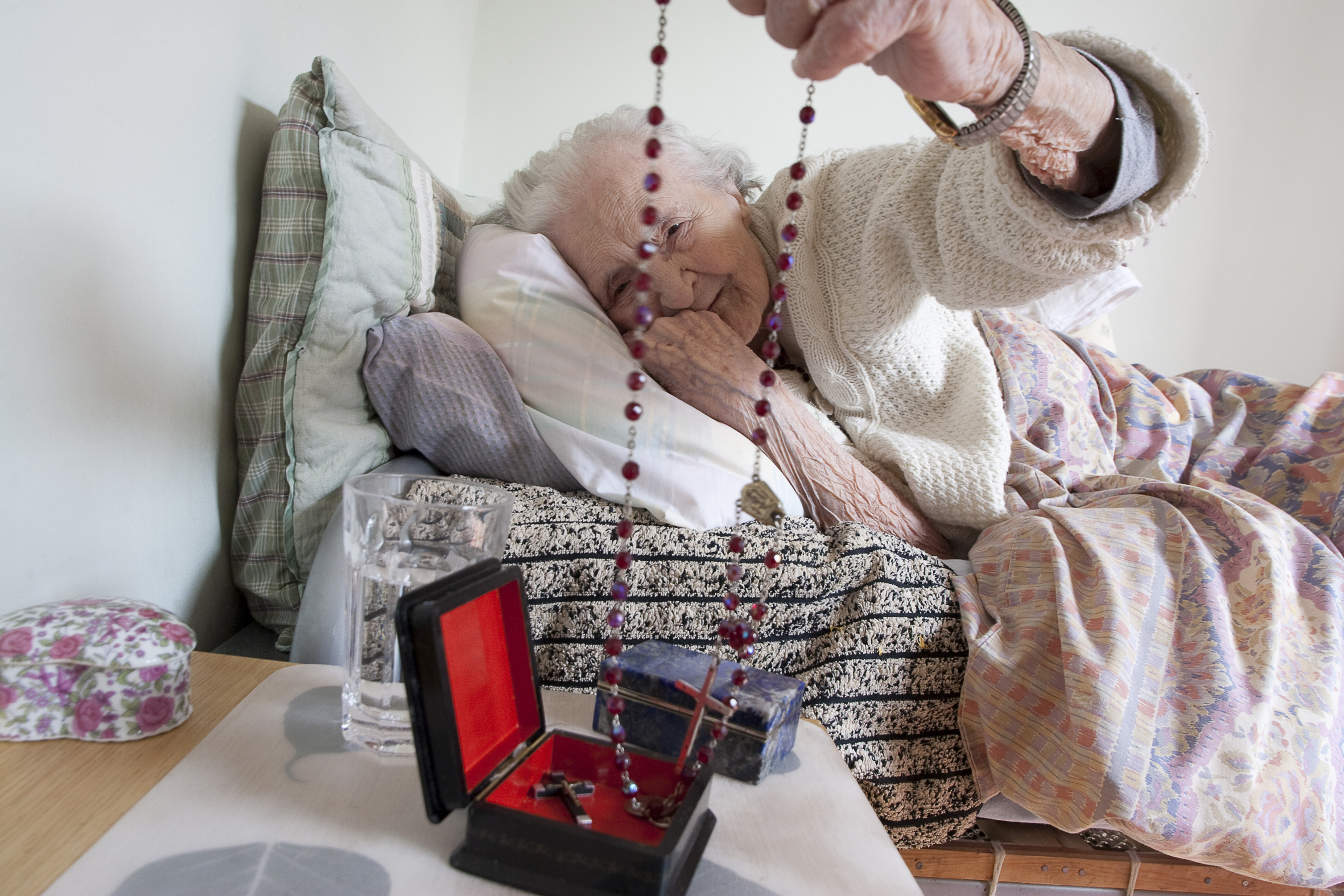
Olga, who fled Russia in 1917 with her mother and settled in London, Photo credit Nadia Bettega
At times of transnational dying, the mundane and the extraordinary, the local and the global flow into one another. For some individuals the sense of being an outsider or belonging elsewhere never leaves. After living in Britain for more than forty years, Dorothy asked to be buried at ‘home’ in Jamaica. She felt that the English earth was too cold for her final resting place. Dorothy told her nurse that she wanted to be surrounded by warmth and people who loved her.
For refugees, death can be a posthumous homecoming or even an inventive lifeline for those they leave behind. Ibrahim felt that if he was buried in Ghana, his baby son might develop an enduring bond with the country, cultures and people. Others I have met are sculpting new traditions from different points of reference. Sanjay, a Hindu migrant from India, wanted his ashes to be scattered in a local park rather than in the Ganges. The South London park was a special place for him and he also wanted to spare his elderly father and family the long and expensive journey to India.
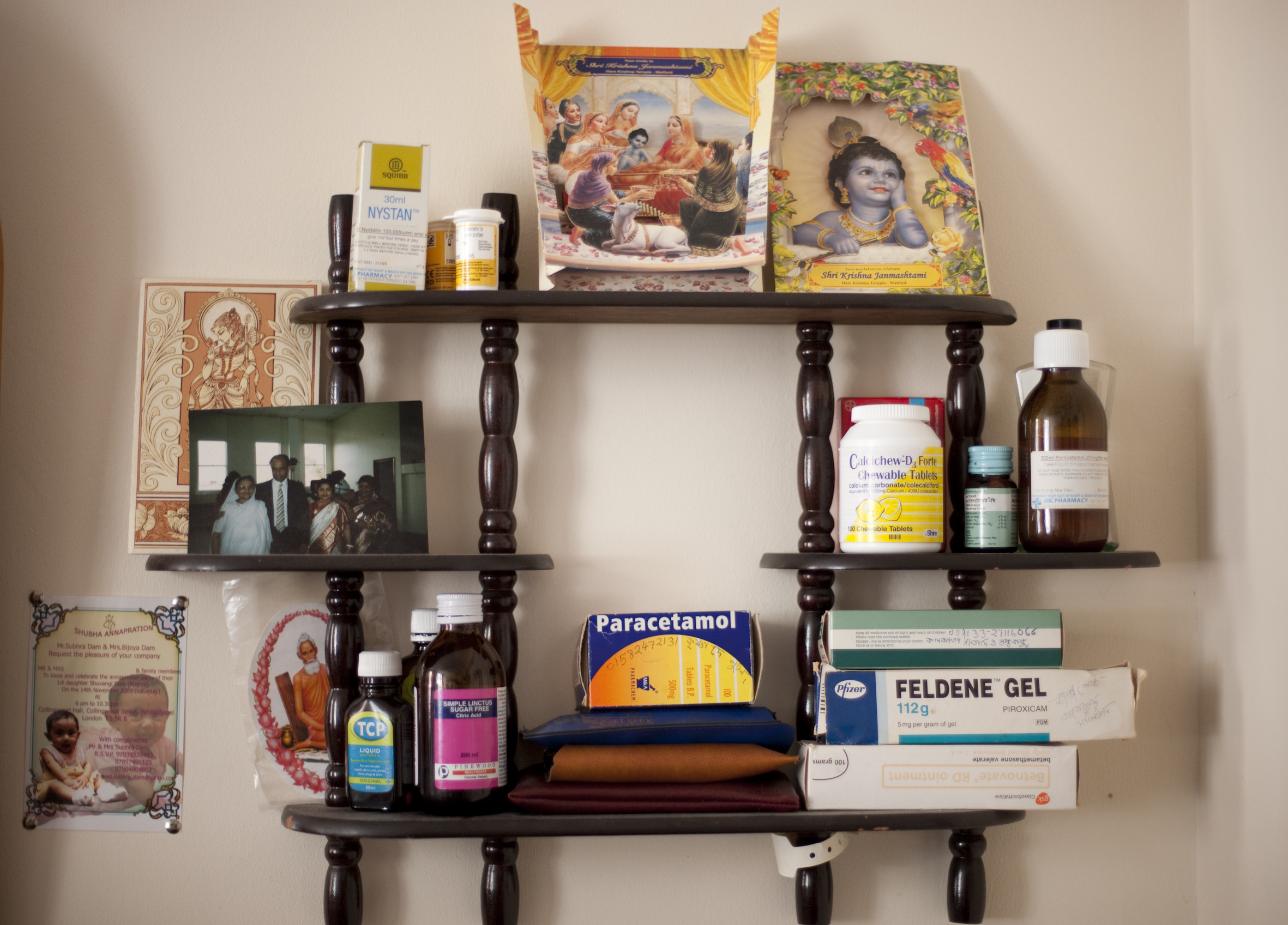
End of life care in a Bengali home in East London, Photo credit Nadia Bettega
Illness, dying and bereavement can bring up and intensify profound questions about belonging and loss for migrants. Yet, as the writer John Berger has pointed out, the dying or infirm migrant is peripheral to Western imagination because of the unrelenting demand for healthy and young migrant labour. So part of my motivation in writing the book is to chip away at this repression. I have also wanted to contribute to conversations about the richness of migrant lives, the hurt and disappointments but also the reverie, the resourcefulness, that search for the surprising beauty of other differences.
Yasmin Gunaratnam teaches in the Sociology department at Goldsmiths College (London). Death and the Migrant is published by Bloomsbury. For further details and to buy a copy visit: http://www.bloomsbury.com/uk/death-and-the-migrant-9781472515339/.
Also see Yasmin’s short film about Transnational Dying in collaboration with Tamasha Theatre Company.
You can follow Yasmin on Twitter @YasminGun.
19 February, 2015
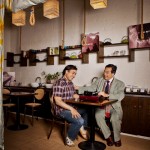

Mike Tsang
Guest blog by photographer Mike Tsang about his exhibition Between East and West. Details of when and where you can see it are at the base of the post.
Between East and West began its life in my teenage years in high school. I went to school in north-west London where there are large communities of migrants – my classmates who I’m still close to now were mostly British-born Indian, Pakistani, Sri Lankan and Chinese. I realise that what really bound us together was growing up navigating between two cultures – the UK and our parents’ homeland. We often spoke about how much we fitted in, or not – mostly joking about whose parents were the strictest and whose family had the most dubious story of poverty whilst growing up (my mum often reminded me that her birthday present was a boiled egg).
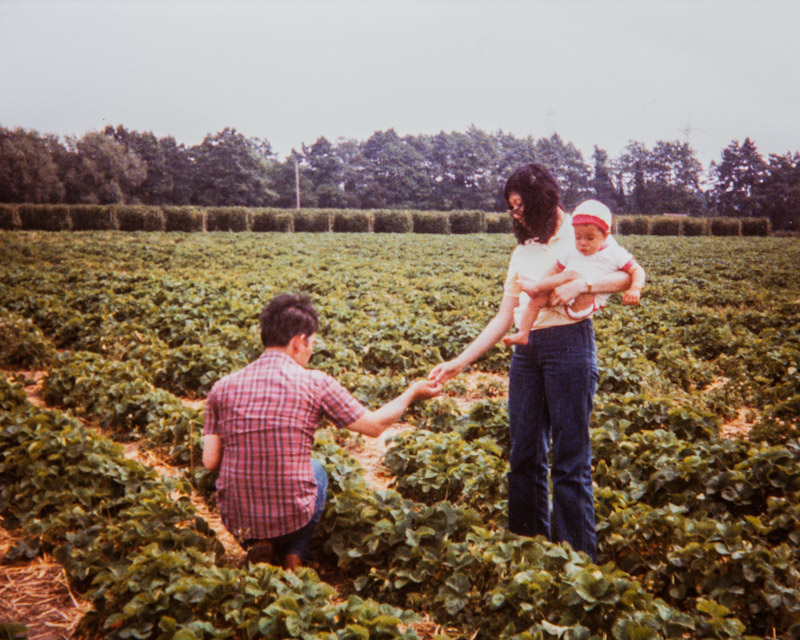
A photo from Mike Tsang’s family archive, strawberry picking with his parents Tony and Myriam during his first summer
My grandparents were Chinese but moved to Mauritius whilst it was still a British colony. My parents were born in Mauritius before emigrating themselves to the UK. So whilst I looked Chinese, I felt twice removed from China growing up, and it was only later in my twenties that I felt a pull to know more about my heritage. More importantly, I realised that British-born Chinese friends had a common subculture – an easy understanding of each other’s jokes and values – that was quite distinct from Chinese migrants to the UK. Often we felt that we didn’t fully belong to either side, compounded by a lack of ability to speak a Chinese language whilst still looking foreign. I decided to record the testimonies of the British-born Chinese and celebrate this, my subculture – one born between two sides but now fully of its own.
The kind assistance of the Heritage Lottery Fund enabled me to begin this project. I spent the first month conducting ‘outreach’ – contacting some Chinese organisations in the UK who could help put me in touch with interview candidates. There is a theory that Chinese in Britain tend to be more disparate than other ethnicities, perhaps due to the tribal history of the country along with the lack of a unifying religion to draw each community together. You don’t really find a body that acts as a unifying force such as the Jewish Community Centre in Hampstead or the Black Cultural Archives in Brixton.
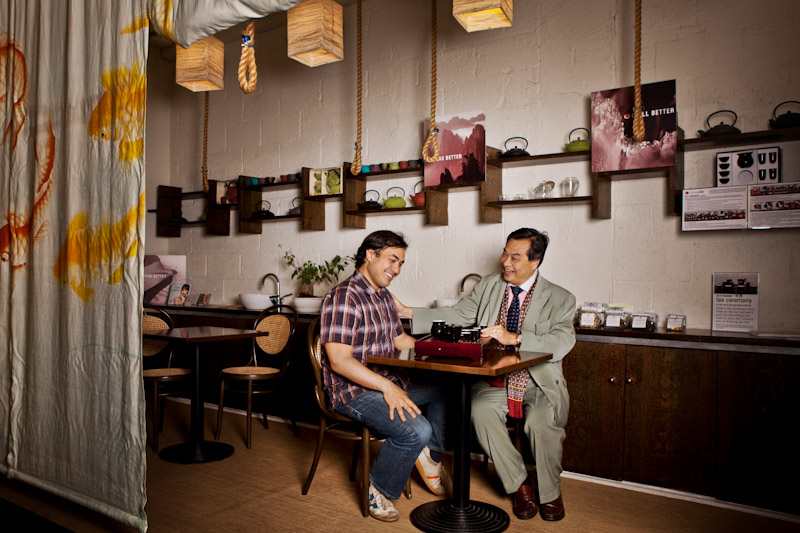
Don Mei – Pictured in his Camden tea house and holistic Chinese medicine shop with his father
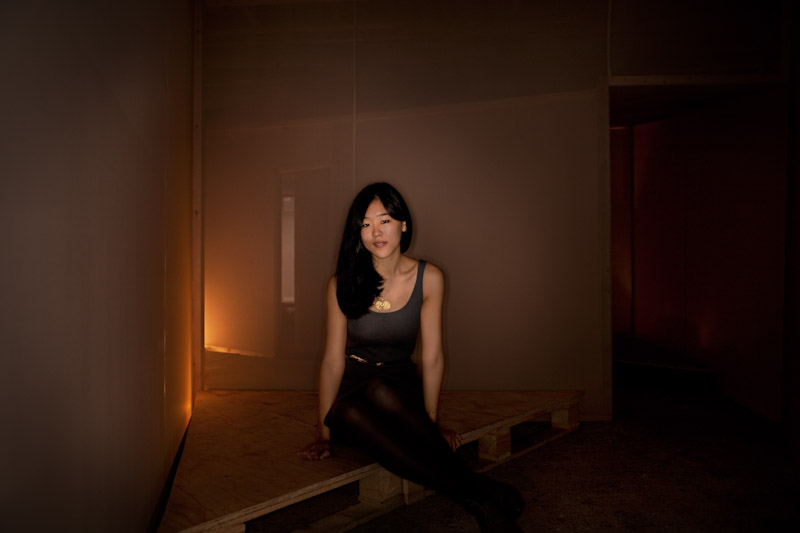
Zoe Chan pictured in her popup architectural space
Momentum grew after the first few interviews and word started spreading about the project, with interviewees coming forward. Then the challenge became selecting people who both had interesting stories to tell whilst still working as part of a group of 15 interviewees that would be broadly representative’ of the British Born Chinese experience. I found it a particular challenge to find women who wanted to tell their story. It was also challenging to do both the oral history interviews and portrait photographs myself as I would have to switch gears and equipment mid-way. I do remember when meeting Lord Nat Wei in the House of Lords, I had only a 30-minute window in which to both interview and take his photo! Luckily his public role had made him concise and we fitted it all in.
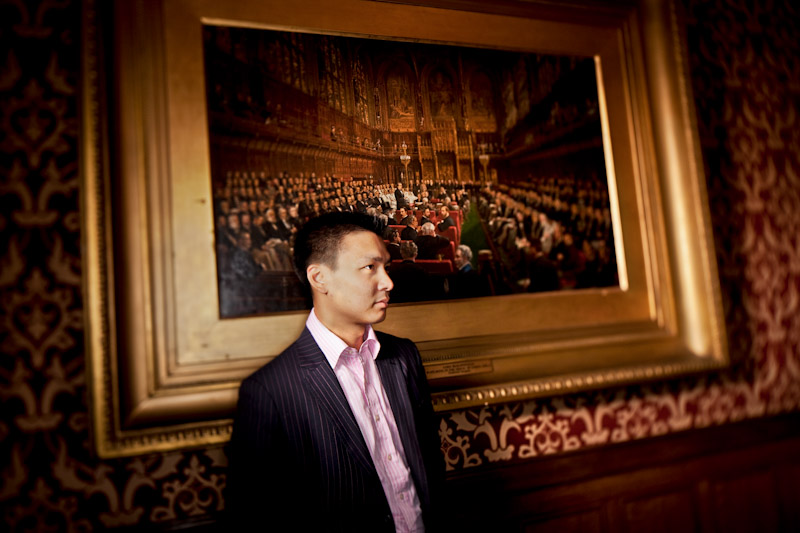
Lord Nat Wei pictured in the House of Lords
Between East and West has had great feedback from people who have seen the exhibition, read the website and bought the project book (see below for shop details). British-born Chinese have told me that they have felt this gave them a voice and set their identity as something different from Chinese in Britain. There has also been unexpectedly great feedback from people of different nationalities saying that the stories of existing between two cultures are “their story too”. I will be interested to hear your views!
____________
Exhibition details:
Monday 23 February – Wednesday 1 April 2015
The London School of Economics and Political Science, Atrium Gallery (LSE Old Building), Houghton Street, London WC2A 2AE
T : +44 (0)20 7405 7686
W: www.lse.ac.uk
Gallery open Monday to Friday 10.00am–8.00pm
Free entry.
Project book available to purchase from www.betweeneastandwest.bigcartel.com
Mike Tsang is also currently looking for people who work in Southwark to tell their story. Contact details can be found on www.southbankstories.com
2 December, 2014
Emily Miller, Education Officer at the Migration Museum Project
How does the language we use to talk about migration and migrants affect our views on migration? This is the question that Michael Rosen dug into in the Migration Museum Project’s inaugural annual lecture at the London School of Economics and Political Science last week.
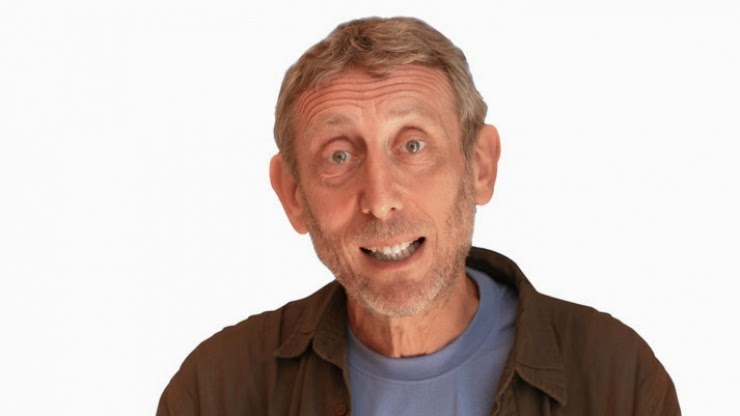
Michael began by engaging directly with the 350 strong audience by executing a quick survey of our personal links to migration: ‘Far too often,’ he says ‘the conversation about migration takes place as if people who have experience of migration are somewhere else, outside over there.’ The show of hands of those assembled in answers to questions about country of origin, working abroad, spousal identity and internal migration demonstrated that the conversation this evening was going to be both about and with those connected with migration.
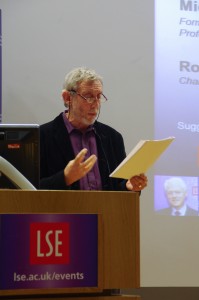
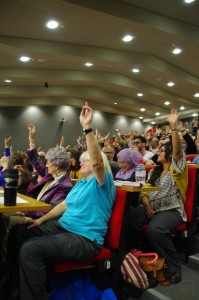
A direct comparison of recent rhetoric about immigration in the USA and the UK formed the main basis of the first part of Michael Rosen’s lecture. He shared a recent speech in which Obama appealed to the US population for tolerance and empathy by spotlighting the story of one individual and her struggle to manage as an undocumented, but hugely hard-working migrant. ‘Are we a nation that kicks out a striving, hopeful immigrant like Astrid, or are we a nation that finds a way to welcome her in? Scripture tells us that we shall not oppress a stranger, for we know the heart of a stranger –- we were strangers once, too’ Obama reminded his audience.

Michael juxtaposed this with recent interviews and soundbites from members of the Conservative party and UKIP, who lay out their stall on migration in very different language. Far from selecting an individual’s narrative, recent immigration is painted as a threatening influx of ‘cheap labour’ and all that connotes. Michael chose, too, to highlight how some politicians avoid an anti-migrant label by implicating the listener in their views with ‘you know what I mean’, a ‘verbal nudge-nudge’ as Rosen names it: while saying everything, it appears to say nothing and makes the listener responsible for the racism.
The lecture came full circle at the end, with an exploration of personal connections with migration. Michael explained his own migration story (Polish Jewish grandparents in the US and UK) and read out his father’s beautifully observed accounts of his father’s wistful reminders of life in Poland: ‘It’s the stuff of a hundred stories, coincidences, losses, and strange meetings’ he elucidated. It is at this point that many of the audience, including me, learned a new word to stick in our proverbial vocabulary pipe: meshuggeneh. You also in the dark? Let me enlighten you. This is yiddish for a crazy or senseless person. In Michaels father’s life it was mostly heard directed from his mother to his father (Michael’s grandparents) as the grandfather swam way out to the end of the pier at Southend and his grandmother feared for his crazy soul!
There then ensued a lively time of questions ably chaired by Robert Winder, trustee of the Migration Museum Project and author of the popular book on UK immigration Bloody Foreigners. One question aimed to elicit Michael’s opinion on the exit of Emily Thornberry from politics following her tweeting the below photo in Rochester during the by-election. Michael said that he does not find the St George Cross in itself a problem but says the risk comes when we interpret signals from flags that might not exist. For example, the owner of this house should not be assumed to hold anti-immigrant views just because of his choice of house decoration.
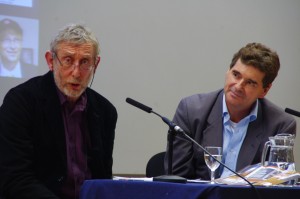

Feedback from the audience following the event was overwhelmingly positive, itself a testament to Michael’s skills. One audience member summed it up as ‘dynamic, engaging, funny and provocative’ – which echoes many others’ analyses.
Another tweeted ‘Excited by the progress towards a UK Migration Museum’ – with which we couldn’t agree more. Stay with us on this journey!
Special thanks to Lord Bhikhu Parekh who initiated and sponsored our annual lecture, Michael Rosen for entertaining and informing us, and the London School of Economics and Political Science for kindly hosting us.


















